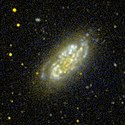NGC 1792
| Galaxie NGC 1792 | |
|---|---|
(c) ESA/Hubble, CC BY 4.0 | |
| Aufnahme mittels Hubble-Weltraumteleskop | |
| AladinLite | |
| Sternbild | Taube |
| Position Äquinoktium: J2000.0, Epoche: J2000.0 | |
| Rektaszension | 05h 05m 14,4s [1] |
| Deklination | −37° 58′ 51″ [1] |
| Erscheinungsbild | |
| Morphologischer Typ | SA(rs)bc / HII[1] |
| Helligkeit (visuell) | 10,0 mag[2] |
| Helligkeit (B-Band) | 10,8 mag[2] |
| Winkelausdehnung | 5,2′ × 2,6′[2] |
| Positionswinkel | 137°[2] |
| Flächenhelligkeit | 12,7 mag/arcmin²[2] |
| Physikalische Daten | |
| Zugehörigkeit | NGC-1808-Gruppe, LGG 127[1][3] |
| Rotverschiebung | 0,004039 ± 0,000007[1] |
| Radialgeschwindigkeit | (1211 ± 2) km/s[1] |
| Hubbledistanz H0 = 73 km/(s • Mpc) | (46 ± 3) · 106 Lj (14,2 ± 1,0) Mpc [1] |
| Durchmesser | 70.000 Lj[4] |
| Geschichte | |
| Entdeckung | James Dunlop |
| Entdeckungsdatum | 4. Oktober 1826 |
| Katalogbezeichnungen | |
| NGC 1792 • PGC 16709 • ESO 305-G006 • MCG -06-12-004 • IRAS 05035-3802 • 2MASX J05051445-3758507 • SGC 050332-3802.8 • AM 0503-380 • GC 1009 • h 2730 • Dun 531 • HIPASS J0505-37 | |
NGC 1792 ist eine Spiralgalaxie vom Hubble-Typ Sbc im Sternbild Taube am Südsternhimmel, die schätzungsweise 46 Millionen Lichtjahre von der Milchstraße entfernt ist.
Die Galaxie wurde am 4. Oktober 1826 von dem schottischen Astronomen James Dunlop entdeckt.[5]
- Die Aufnahme mit dem Very Large Telescope zeigt lichtschwache Bereiche
- Ultraviolettemission, abgebildet mittels GALEX
Weblinks
Einzelnachweise
Auf dieser Seite verwendete Medien
(c) ESA/Hubble, CC BY 4.0
The Stellar Forge
An orange glow radiates from the centre of NGC 1792, the heart of this stellar forge. Captured by the NASA/ESA Hubble Space Telescope, this intimate view of NGC 1792 gives us some insight into this galactic powerhouse. The vast swathes of tell-tale blue seen throughout the galaxy indicate areas that are full of young, hot stars, and it is in the shades of orange, seen nearer the centre, that the older, cooler stars reside.
Nestled in the constellation of Columba (The Dove), NGC 1792 is both a spiral galaxy, and a starburst galaxy. Within starburst galaxies, stars are forming at comparatively exorbitant rates. The rate of star formation can be more than 10 times faster in a starburst galaxy than in the Milky Way. When galaxies have a large resevoir of gas, like NGC 1792, these short lived starburst phases can be sparked by galactic events such as mergers and tidal interactions. One might think that these starburst galaxies would easily consume all of their gas in a large forming event. However, supernova explosions and intense stellar winds produced in these powerful starbursts can inject energy into the gas and disperse it. This halts the star formation before it can completely deplete the galaxy of all its fuel. Scientists are actively working to understand this complex interplay between the dynamics that drive and quench these fierce bursts of star formation.
Credit:
ESA/Hubble & NASA, J. Lee Acknowledgement: Leo Shatz
Coordinates Position (RA): 5 5 13.98 Position (Dec): -37° 58' 48.78" Field of view: 2.67 x 2.51 arcminutes Orientation: North is 208.9° right of vertical
Colours & filters Band Wavelength Telescope Ultraviolet UV 275 nm Hubble Space Telescope WFC3 Optical U 336 nm Hubble Space Telescope WFC3 Optical B 438 nm Hubble Space Telescope WFC3 Optical V 555 nm Hubble Space Telescope WFC3 Optical I 814 nm Hubble Space Telescope WFC3.
Autor/Urheber: ESO, Lizenz: CC BY 4.0
Colour composite image of the starburst spiral galaxy NGC 1792 obtained with the FORS1 and FORS2 multi-mode instruments (at VLT MELIPAL and YEPUN, respectively). Its optical appearance of NGC 1792 is quite chaotic, due to the patchy distribution of dust throughout the disc of this galaxy. It is very rich in neutral hydrogen gas - fuel for the formation of new stars - and is indeed rapidly forming such stars. The galaxy is characterized by unusually luminous far-infrared radiation; this is due to dust heated by young stars. Note the numerous background galaxies in this sky field. North is up and East is to the left.
ID: phot-33b-03-fullres
Size: 2297x2306
Credit: ESO




